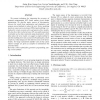Free Online Productivity Tools
i2Speak
i2Symbol
i2OCR
iTex2Img
iWeb2Print
iWeb2Shot
i2Type
iPdf2Split
iPdf2Merge
i2Bopomofo
i2Arabic
i2Style
i2Image
i2PDF
iLatex2Rtf
Sci2ools
ICCAD
2004
IEEE
2004
IEEE
Techniques for improving the accuracy of geometric-programming based analog circuit design optimization
We present techniques for improving the accuracy of geometric-programming (GP) based analog circuit design optimization. We describe major sources of discrepancies between the results from optimization and simulation, and propose several methods to reduce the error. Device modeling based on convex piecewise-linear (PWL) function fitting is introduced to create accurate active and passive device models. We also show that in selected cases GP can enable nonconvex constraints such as bias constraints using monotonicity, which help reduce the error. Lastly, we suggest a simple method to take the modeling error into account in GP optimization, which results in a robust design over the inherent errors in GP device models. Two-stage operational amplifier and on-chip spiral inductor designs are given as examples to demonstrate the presented ideas.
Related Content
| Added | 16 Mar 2010 |
| Updated | 16 Mar 2010 |
| Type | Conference |
| Year | 2004 |
| Where | ICCAD |
| Authors | Jintae Kim, Jaeseo Lee, Lieven Vandenberghe |
Comments (0)

